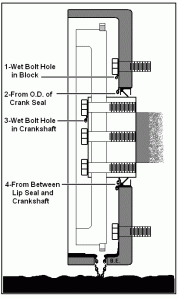One of the more important maintenance items to watch with generator sets is the engine’s rear crankshaft seal. When the seal fails, engine oil leaks into the flywheel housing between the generator windings and the engine. A quick inspection of the air discharge end of the generator can tell if there is a build up of oil and dust. Oil visible in the flywheel housing should serve as a red flag signaling the need for maintenance.
The general drawing to the left here shows possible sources of oil leaks in the flywheel housing, however, most newer engines do not have wet bolt holes in the crankshaft or flywheel housing bolt holes.
Inside the flywheel housing are three things: 1-The drive plates that couple the generator shaft to the flywheel, 2-The engine’s flywheel, and 3-The engine’s rear crankshaft seal.
Generator engines normally turn at either 1,800 RPM or 1,200 RPM. Therefore, any oil that leaks past the rear seal is flung outward by the spinning action of the flywheel. The oil is then picked up by the air coming from the generator fan and becomes an airborne mist. This oily mist is carried throughout the generator enclosure because of the tremendous amount of cooling air that the generator fan moves through the generator. Many generator sets move between 500 and 1,200 cubic feet of cooling air per minute (CFM). This means that, in a small engine room, several times the volume of air in the enclosure can pass through the generator every minute.
Unfortunately, the oily mist re-circulates back to the air intake portion of the generator and is pulled through the generator again and again. This puts a uniform coat of oil on every part of the generator. The oily mist is also pulled into the generator engine’s air filter. In fact, any engines running nearby will draw oil into their air filters causing premature airflow restriction.
Oil on the generator windings acts as an insulator, slowing heat transfer. This will prevent the windings from being adequately cooled.
Speaking of generator winding insulation, other related problems occur when there is the least amount of water or salt spray coming into the generator air-stream. Even splash from bilge water, on board a boat, in rough weather can find its way into the air stream that is passing through the generator end. The problem here is that water contains minerals that will carry electrical current and can cause a short circuit if a crack develops in the winding’s insulation. Bilge water also carries microorganisms that eat the insulation from the windings in the generator.
In fact, generator winding insulation is degraded when anything other than cool dry air passes through the generator including dust, oil, fresh water, or saltwater.
At the first hint of a seeping rear seal, it’s time to find out if the seal has failed, or there is some other problem.
As you begin to troubleshoot the oil leak, first check the engine oil level to learn if the level is too high. A high oil level can cause even a good seal to leak. Someone may have filled the engine with too much oil. Or, perhaps the engine may be mounted at an extreme angle. It is also possible that you may need to check the dipstick calibration. Each engine maker has a suggested method for calibrating the dipstick. Refer to your engine manual.
Fuel or coolant leaking into the engine’s oil pan can explain a high oil level in the engine. Yet another cause of a rear seal leak is a restricted crankcase vent line. When pressure in the crankcase gets above two pounds per square inch (PSI) the rear crankshaft seal will usually fail.
Engines that have wet bolt holes in the flywheel-mounting flange can experience a leak through one or more bolt holes, too. Some engines also have wet bolt holes in the flywheel housing that can mimic a rear seal failure.
Note: A wet bolt hole is one that allows the bolt to thread into part of the engine that contains engine crankcase oil.
One more reason for rear seal failure occurs when an engine has many hours of service and the rear main bearing has worn excessively. In this case the crankshaft can wobble as it turns while the engine is being started. This wobble will cause the rear seal to leak. The rear main crankshaft bearing will often wear more than the front engine bearings because the engine must start dry with the weight of the generator’s revolving member hanging on the flywheel. ![]()
(Some of this material excerpted from “PRACTICAL BOAT MECHANICS”, by Ben L. Evridge, to be published this fall.)


Recent Comments